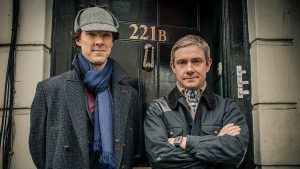When I introduce any Victorian literature to students, I initially ask them to brainstorm words they associate with Victorian, and I write their responses on the blackboard. Overwhelmingly, they see the period and its figures as resoundingly restrained. Though many American college students define the Victorians by their apparently repressed sexuality, troubling gender relations, and long, rambling novels, the truth is that the Victorian period is strikingly parallel to our current moment. Part of teaching Victorian literature is debunking—or at least adding nuance to—students’ preconceived judgments.

Benedict Cumberbatch (Sherlock) and Martin Freeman (Watson)
in the BBC series Sherlock, a modern-day rendition of the nineteenth- century Sir Arthur Conan Doyle collection.
My experience with undergraduates understanding the validity and use of Victorian novels in today’s world led to a summer course I put together titled “Victorians Then and Now.” My syllabus aimed to address various ways in which the Victorian period is analogous to our own and therefore defend the usefulness of studying the nineteenth century, not just for its own literary innovations, but for its illuminations of our current political and philosophical climate. My course pointed out that the Industrial Revolution is akin to our technological one; serial publication of novels entertained the Victorians the way televised miniseries such as The Wire or Mad Men entertain us, and nineteenth-century questions of gender relations are the kernels of our own arguably more complex discourse on gender.
We began with Brontë’s Jane Eyre and watched the most recent film adaptation—Cary Fukunaga’s 2011 adaptation—starring Michael Fassbender as Mr. Rochester and Mia Waskikowska as Jane Eyre. Jane Eyre (the novel) is often deemed by critics and contemporary readers ahead of its time because of the singularity of its eponymous heroine. Jane, though repeatedly self-portrayed as “plain,” “little,” and “obscure,” is paradoxically outspoken and fiercely independent. The novel reveals that the issues Brontë was thinking about through her characterization of Jane are not so far off from today’s world when it comes to women and gender. Jane’s famous statement that “women feel just as men feel” brings to light the double standard that is also rigorously examined in this most recent race for the United States’ presidency, and my students commented on these sorts of parallels in our discussions.

Mia Wasikowska (Jane Eyre) and Michael Fassbender (Mr. Rochester)
in Cary Fukunaga’s 2011 adaptation of Jane Eyre
My students found that repeated iterations of Jane Eyre show that the novel has endured precisely because it deals so arrestingly with issues that are still troubling today. The novel addresses the mistreatment of women but also the disenfranchised in general, and it ends with Jane’s quite disturbing concession, “Reader, I married him.” That Jane agrees to marry Rochester is met with a certain degree of cognitive dissonance: in one way, readers want the novel to end in a neat marriage plot and for Jane to be happy—Jane even says in the novel “I would always rather be happy than dignified”—but in another sense, her decision to marry Rochester also feels something like resignation. My students concluded that the 2011 film’s overall mood and tone—and what it chooses to include and leave out—display the skepticism, fear, and uncertainty of our present time: ideas quietly suggested in the text but picked up more robustly for a contemporary audience.
Perhaps the most successful moment in the course, however, was when I assigned my students Charles Dickens’s Hard Times, an industrial novel that takes place in a fictional factory town called Coketown, in which factories and Malthusian economics rule. The conceit of the novel is to pit “fancy” and “fact” against each other—dueling ideologies that Dickens felt dominated his time—to reveal the dehumanizing aspect of industrialization, of so-called progress. Rather than curating a way in which to see Hard Times in our current moment, I had my students present contemporary issues that connected with the novel.
Their projects were creative and insightful. One student titled his presentation “Josiah & Me: Hard Times and the Real Working Class,” and connected the novel’s character Josiah Bounderby, a contemptable and dishonest entrepreneur, to General Motors CEO Roger Smith in scenes from Michael Moore’s documentary Roger and Me, which deals with the distressing and exploitive business practices of Smith in Flint, Michigan. Another student explored the connection between today’s technological advancements and industrialization in Hard Times, pointing to an NPR interactive website that predicted the chances of certain jobs being transferred to machines.
In his New York Times Op-Ed, Brown University literature professor Arnold Weinstein writes, “The humanities interrogate us. They challenge our sense of who we are, even of who our brothers and sister might be. When President Obama said of Trayvon Martin, ‘this could have been my son,’ he was uttering a truth that goes beyond compassion and reaches toward recognition. ‘It could have been me’ is the threshold for the vistas that literature and art make available to us.” Though Weinstein is speaking more generally about why the humanities matter, I find myself using his logic to explain why specifically the Victorian period matters. Dedicating ourselves to look back on a period of intense innovation and change—a period often called “the age of doubt” because of such simultaneous fear of and embrace of progress—brings us a certain degree of hopefulness. If the Victorians got through it, so can we. Human connection and understanding, really only rendered through art, are what lasts, what matters, and what will sustain us.
Works Cited
Weinstein, Arnold. “Don’t Turn Away from the Art of Life.” New York Times, 23 Feb 2016, https://www.nytimes.com/2016/02/24/opinion/dont-turn-away-from-the-art-of-life.html?_r=1. Accessed 30 March 2017.



Great article. http://webesser.com